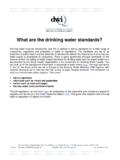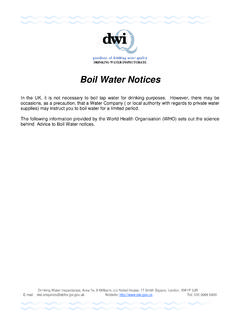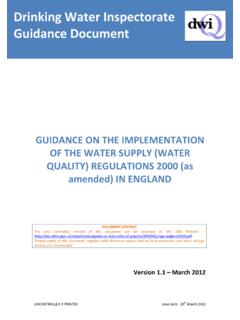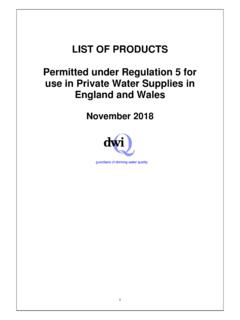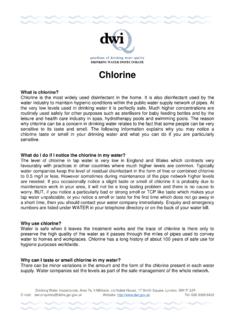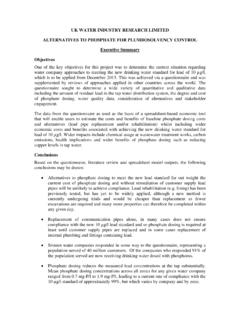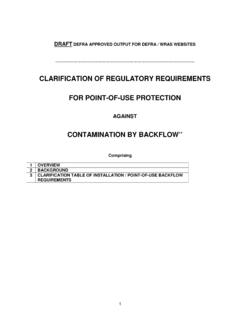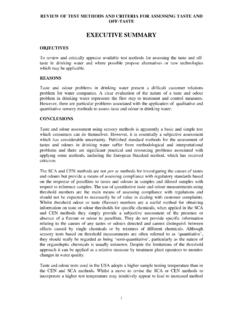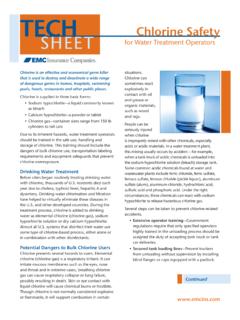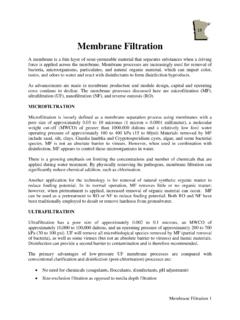Transcription of 5. Water treatment processes - DWI, UK
1 5. Water treatment processes Introduction Larger Water supplies serving many properties or commercial or industrial premises usually have shared upstream treatment systems similar in principle to those used at municipal Water treatment works. This means that Water is fully treated before being supplied to a distribution system from where it will go on to feed consumers. Smaller supplies, such as those feeding individual properties, would normally still be expected to have a suitable form of treatment situated such that it will provide Water for drinking and other domestic uses at all points in the property, although there are exceptions which are discussed later (see section 6). It is essential that the design of any treatment process is based on a full investigation of site conditions, including chemical and microbiological analysis of the Water to be treated, a risk assessment and the results of laboratory or pilot scale tests to determine the effectiveness of the process and the chemical dosing requirements.
2 This chapter provides an overview of the basic principles of Water treatment ; anyone planning to install or upgrade a Water treatment process should seek expert guidance. Where Water is used for any domestic purposes it must be wholesome. Requirement for treatment may vary according to rainfall, catchment activity or other reasons. Although monitoring may indicate that the Water is bacteriologically safe some of the time, it is extremely likely that there will be a bacteriological challenge at other times. In practice this means that many supplies will require a disinfection stage unless the supply can be shown by risk assessment and frequent surveillance to be likely to be consistently pathogen free. It is important to choose equipment, suppliers and consultants carefully. DWI has published a list of products and substances which are approved for use which is available at This provides information on permitted products, their suppliers and lists some common types of products.
3 Purchasers of Water treatment plant and supplies should: ensure that potential suppliers are aware of the size and nature of the Water supply confirm that potential suppliers can supply and install (if required) equipment suitable and approved for use with private Water supplies establish whether suppliers can provide references relating to similar projects if practicable inspect other, similar, installations 1. ensure that instructions for use and ongoing management and maintenance requirements of the equipment are provided The DWI has produced a checklist for treatment which may be found at This shows basic treatment capabilities of commonly found treatment options. A range of Water treatment processes is covered here and in the following chapter, which deals with point-of-use systems for treatment of Water at a single tap.
4 For some contaminants, potentially several techniques could be appropriate. For example, membrane processes can remove a broad spectrum of contaminants but cheaper and simpler alternatives may be just as effective in particular cases. It is likely that a combination of processes will be required to deal with the majority of waters, for example filtration followed by UV to remove particles and inactivate microorganisms. Multiple barriers Virtually all Water sources require treatment prior to consumption to ensure that they do not present a health risk to the user. Health risks from poor quality Water will often be due to microbiological or chemical contamination. Absence of microbiological contamination is generally the most important to human health as pathogens can lead to infectious diseases.
5 Chemical contamination, with the exception of a few substances such as cyanide, tend to represent a more long term health risk. Substances in Water which affect its appearance, odour or taste may make Water objectionable to consumers and lead to rejection on aesthetic grounds. As microorganisms can be associated with particles and turbidity in Water , physical contamination may also represent a health risk as it makes disinfection more difficult. Most treatment systems are designed to remove microbiological contamination and those physical constituents, such as suspended solids (turbidity) that affect aesthetic acceptability or prevent effective disinfection. A final disinfection stage is nearly always included at the end of the treatment process to inactivate any remaining microorganisms. When a persistent disinfectant, such as chlorine, is applied this also provides a residual that will act as a preservative to prevent biological regrowth during storage and/or distribution in larger systems.
6 treatment processes are based on the physical removal of contaminants through filtration, settling (often aided by some form of chemical addition) or biological removal of microorganisms. Usually, treatment consists of a number of stages, with initial pre- treatment by settling or pre-filtration through coarse media, filtration followed by chlorination. This is called the multiple barrier principle. The multiple barrier approach is an important concept as it provides the basis for effective treatment of Water and allows each individual process stage to treat Water to a suitable quality for subsequent downstream processes ( filtration can 2. prepare Water to ensure it is suitable for UV disinfection). Effective treatment of a supply does not therefore rely on one key stage or process. The multiple barrier principle applies throughout the supply from catchment all the way to the consumer's tap.
7 Proper selection and protection of Water sources are of prime importance in the provision of safe drinking Water . The subsurface is often an effective medium for attenuating contaminants present in the catchment while the design and good maintenance of the well, borehole, spring or intake can help exclude localised pollution from surface runoff. It is always better to protect Water from contamination than to treat it after it has been contaminated. Effective source protection, careful choice of aquifer or Water intake and well designed and maintained abstraction structures all constitute effective barriers in the multiple barrier principle. Coagulation and flocculation Coagulation and flocculation are used to remove colour, turbidity, algae and other microorganisms from surface waters. The addition of a chemical coagulant to the Water causes the formation of a precipitate, or floc, which entraps these impurities.
8 Iron and aluminium can also be removed under suitable conditions. The floc is separated from the treated Water by sedimentation and/or filtration, although flotation processes may be used in place of sedimentation. The most commonly used coagulants are aluminium sulphate and ferric sulphate, although other coagulants are available. Coagulants are dosed in solution at a rate determined by raw Water quality near the inlet of a mixing tank or flocculator. The coagulant is rapidly and thoroughly dispersed on dosing by adding it at a point of high turbulence. The Water is allowed to flocculate and then passes into the sedimentation tank (sometimes known as a clarifier) to allow aggregation of the flocs, which settle out to form sludge. This sludge will need to be periodically removed. The advantages of coagulation are that it reduces the time required to settle out suspended solids and is very effective in removing fine particles that are otherwise very difficult to remove.
9 Coagulation can also be effective in removing many protozoa, bacteria and viruses. The principal disadvantages of using coagulants for treatment of small supplies are the cost and the need for accurate dosing, thorough mixing and frequent monitoring. Coagulants need accurate dosing equipment to function efficiently and the dose required depends on raw Water quality that can vary rapidly. The efficiency of the coagulation process depends on the raw Water properties, the coagulant used and operational factors including mixing conditions, temperature, coagulant dose rate and pH value. The choice of coagulant and determination of optimum operating 3. conditions for a specific raw Water are normally determined by bench scale coagulation tests. Thus, while coagulation and flocculation are the most effective treatment for removal of colour and turbidity they may not be suitable for small Water supplies because of the level of control required and the need to dispose of significant volumes of sludge.
10 Sedimentation Simple sedimentation ( unassisted by coagulation) may be used to reduce turbidity and solids in suspension. Sedimentation tanks are designed to reduce the velocity of flow of Water so as to permit suspended solids to settle under gravity. There are many different designs of tanks and selection is based on simple settlement tests or by experience of existing tanks treating similar waters. Without the aid of coagulation, these will only remove large or heavy particles, and due to the length of time this process will take, the system will usually require storage tanks to balance peaks and troughs in demand. Sedimentation tanks are usually rectangular with length to width ratios between 2:1. and 5:1. The depth of the tank is usually between and The inlet and outlet must be at opposite ends of the tank.
